The Interference Mechanism and Regularity Analysis of Gas Pipelines Affected by High-Speed Rail Based on Field Testing and Numerical Simulation
Abstract
1. Introduction
2. Discussion on the Forms of AC Interference on Pipelines from High-Speed Railways
3. Measurement Methods
4. Basic Overview of Three Pipelines and High-Speed Railway Line
5. Test Results and Analysis
5.1. Test Results of Pipeline and High-Speed Railway Intersections
5.2. Test Results of Parallel Intersection Between Pipeline and High-Speed Railway
5.3. Analysis of AC Interference Patterns on Pipelines Affected by High-Speed Railway
6. Analysis of Interference Patterns Based on Numerical Simulation
7. Conclusions
- (1)
- The interference caused by the parallel and crossover conditions of high-speed railway and pipelines is much greater than that caused by the crossing condition alone.
- (2)
- When the gas pipeline intersects with the high-speed railway at certain points and runs parallel in other sections, the peak point of the AC interference voltage of the pipeline will occur at the insulation joint position of the pipeline, the position of the pipeline corresponding to the high-speed railway AT, and the position of the pipeline corresponding to the train running point.
- (3)
- The peak value of resistive coupling interference caused by high-speed railway to pipelines appears at the moment when the train passes, while the peak value of electromagnetic coupling interference caused by high-speed railway to pipelines does not appear at the moment when the train passes.
- (4)
- The AC interference caused by high-speed railway to pipelines is caused by the superposition of resistive coupling interference and electromagnetic coupling interference. For this case, the interference caused by inductive coupling plays a dominant role.
Author Contributions
Funding
Institutional Review Board Statement
Informed Consent Statement
Data Availability Statement
Conflicts of Interest
References
- Guo, Y.B.; Cheng, L.; Wang, D.G.; Liu, S.H. Effects of alternating current interference on corrosion of X60 pipeline steel. Petrol. Sci. 2015, 12, 316–324. [Google Scholar] [CrossRef]
- Qin, Q.Y.; Xu, J.; Wei, B.X.; Fu, Q.; Gao, L.Q.; Yu, C.K.; Sun, C.; Wang, Z. Synergistic effect of alternating current and sulfate-reducing bacteria on corrosion behavior of X80 steel in coastal saline soil. Bioelectrochemistry 2021, 142, 107911. [Google Scholar] [CrossRef]
- Guo, Q.R.; He, W.Z.; Zuo, G.; Dong, Z.Z.; Chen, J.H.; Li, Z.P.; Leng, X.Y.; Li, Z.H. Study on the interference of electrified railway on oil pipeline and its protection method. Petrol. Eng. Constr. 2005, 4, 51–54. [Google Scholar] [CrossRef]
- Wang, K. Influence of Electrified Railway on Oil and Gas Pipeline and Protective Measures. Ph.D. Thesis, Southwest Jiaotong University, Chengdu, China, 2013. [Google Scholar]
- Xian, J.; Wang, W.B.; Mei, P.; Zhang, H.W.; Xu, J.; Sun, C.; Yan, M.C.; Wu, T.Q.; Yu, C.K. Effect of Stray Current Induced by Electric Railway on Buried Pipeline. Total Corros. Control 2013, 27, 42–46. [Google Scholar]
- Li, N.X. Protection measures against electromagnetic interference from oil and gas pipelines by high-speed electrified railways. Guide Bus. 2015, 15, 148. [Google Scholar]
- Wei, X. Study on Corrosion Interference of AC Electrified Railway on Buried Pipeline. Ph.D. Thesis, China University of Petroleum, Qingdao, China, 2012. [Google Scholar]
- Chen, L. Detection and protection measures of AC stray current interference of oil pipeline in southern Jiangsu Province. Corros. Prot. 2015, 36, 779–783. [Google Scholar]
- Wu, C.F.; Wang, B.; Pei, Q.; Zhou, B.K.; Chen, H.Y.; Xue, Z.Y. AC Stray Current Testing and Evaluation of the Tieling-Qinhuangdao Pipeline. Pipeline Technol. Equip. 2014, 1, 36–38. [Google Scholar]
- Fickert, L.; Schmautzer, E.; Braunstein, R.; Lindinger, M. Reduction of the electrical potential of interfered pipelines due to currents of high voltage power lines and electric railways. Elektrotech. Inftech. 2010, 127, 362–366. [Google Scholar] [CrossRef]
- Linhardt, P.; Ball, G. AC Corrosion: Results from Laboratory Investigations and from a Failure Analysis. In Proceedings of the Corrosion 2006 Conference, San Diego, CA, USA, 12–16 March 2006; pp. 1–9. [Google Scholar]
- Bosko, M.; Bozidar, F.G.; Tomislav, R. Electromagnetic fields and induced voltages on underground pipeline in the vicinity of AC traction system. J. Energy Power Eng. 2014, 8, 1333. [Google Scholar]
- Hosokawa, Y.; Kajiyama, F.; Nakamura, Y. New cathodic protection criteria based on direct and alternating current densities measured using coupons and their application to modern steel pipelines. Corrosion 2004, 60, 304. [Google Scholar] [CrossRef]
- Zhu, J.G. Research on Electromagnetic Interference Characteristics of Underground Oil and Gas Pipelines Caused by Electrified Railway Communication. Ph.D. Thesis, Southwest Jiaotong University, Chengdu, China, 2018. [Google Scholar]
- Charalambous, C.A.; Demetriou, A.; Lazari, A.; Nikolaidis, A. Effects of Electromagnetic Interference on Underground Pipelines caused by the Operation of High Voltage A.C. Traction Systems: The Impact of Harmonics. IEEE Trans. Power Deliv. 2018, 33, 2664–2672. [Google Scholar] [CrossRef]
- Zhang, X.Y. Calculation and protective measures of electromagnetic interference induced by electrified railway on the oil and gas pipelines. Oil Depot Gas Stat. 2010, 19, 29. [Google Scholar]
- Li, X.F.; Liu, S.X. The impact of electrified railways on AC interference voltage of buried natural gas pipelines. Petrochem. Technol. 2019, 26, 64–66. [Google Scholar]
- Mariscotti, A. Distribution of the traction return current in AC and DC electric railway systems. IEEE Trans. Power Deliv. 2003, 18, 1422–1432. [Google Scholar] [CrossRef]
- Kolar, V.; Hrbac, R.; Mlcak, T. Measurement and simulation of stray currents caused by AC railway traction. In Proceedings of the 16th International Scientific Conference on Electric Power Engineering (EPE), Kouty nad Desnou, Czech Republic, 20–22 May 2015. [Google Scholar]
- Sun, P.Q. AC Interference induced by electrified railway on buried metal pipelines and its protective measures. Urban Gas 2011, 4, 7. [Google Scholar]
- Braunstein, R.; Schmautzer, E.; Graz, G.P. Comparison and discussion on potential mitigating measures regarding inductive interference of metallic pipelines. In Proceedings of the Electrical Systems for Aircraft, Railway and Ship Propulsion (ESARS/2010), Bologna, Italy, 19–21 October 2010. [Google Scholar]
- Milesevic, B.; Filipovic-Grcic, B.; Uglesic, I.; Jurisic, B. Estimation of current distribution in the electric railway system in the EMTP-RV. Electr. Power Syst. Res. 2018, 162, 83–88. [Google Scholar] [CrossRef]
- Farahani, E.M.; Su, Y.; Chen, X.; Wang, H.; Laughorn, T.R.; Onesto, F.; Zhou, Q.; Huang, Q. AC corrosion of steel pipeline under cathodic protection: A state-of-the-art review. Mater. Corros. 2024, 75, 290–314. [Google Scholar] [CrossRef]
- Lucca, G. AC corrosion on pipelines: Influence of the surface layer soil resistivity in evaluating the current density by a probabilistic approach. Prog. Electromagn. Res. 2019, 79, 175–186. [Google Scholar] [CrossRef]
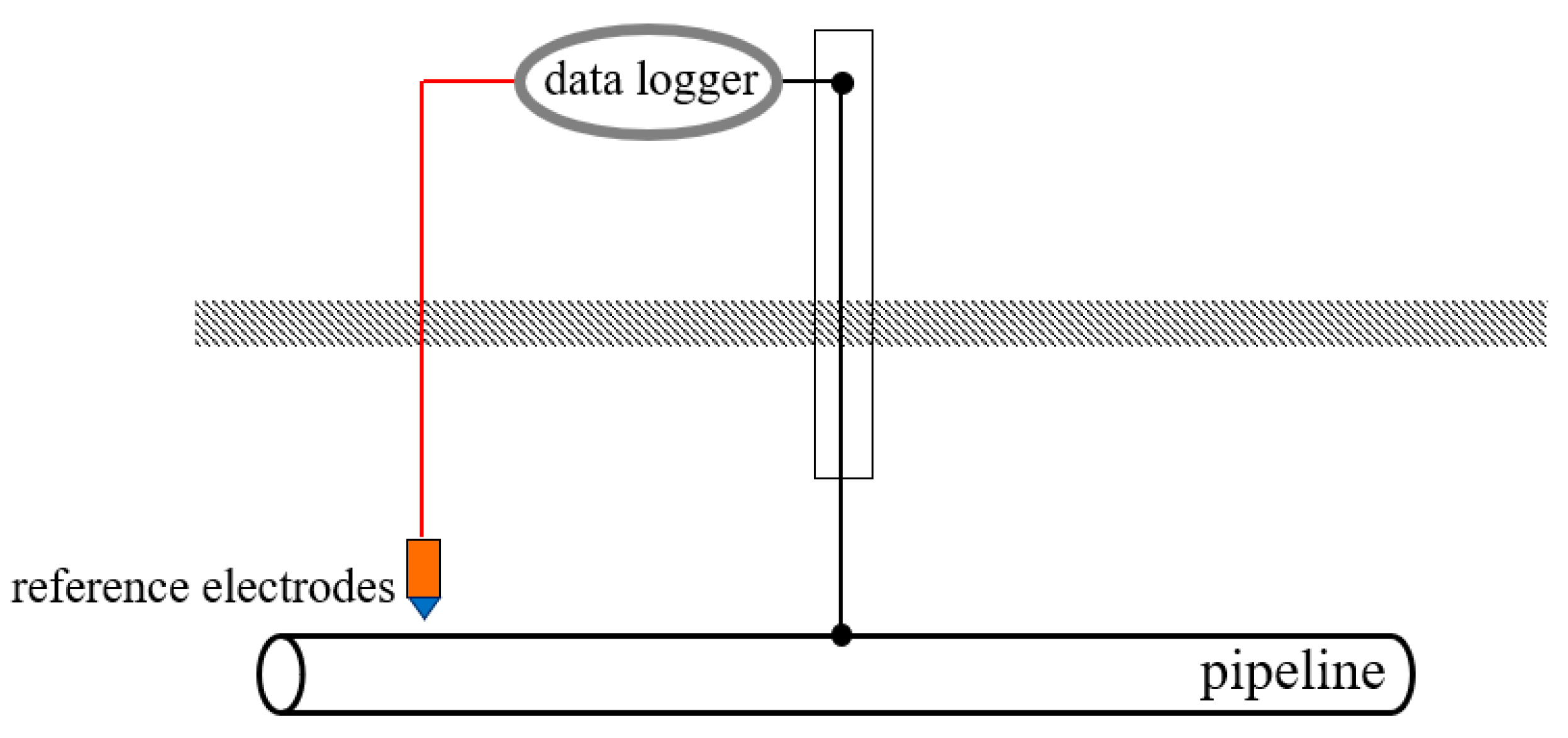
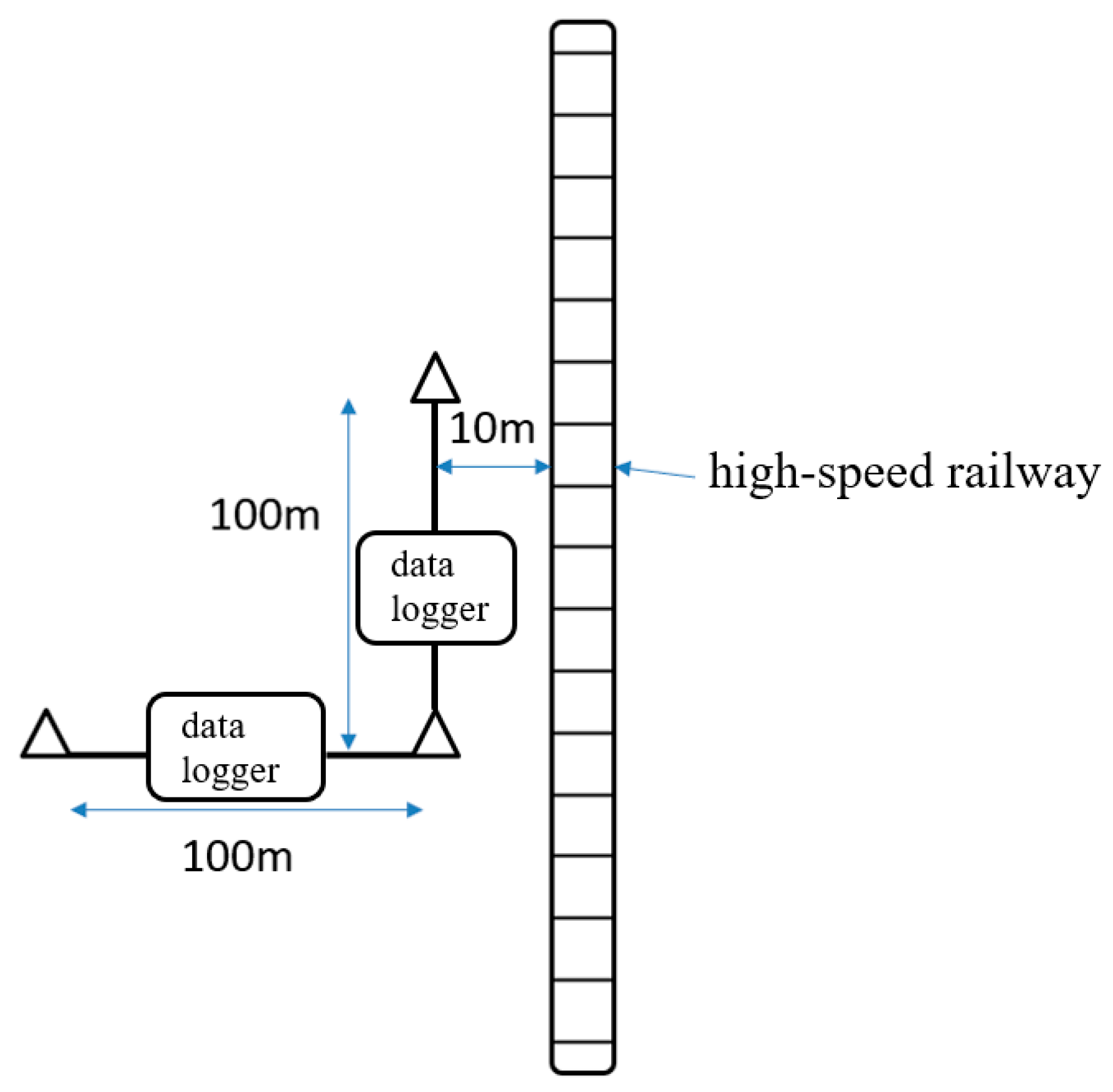

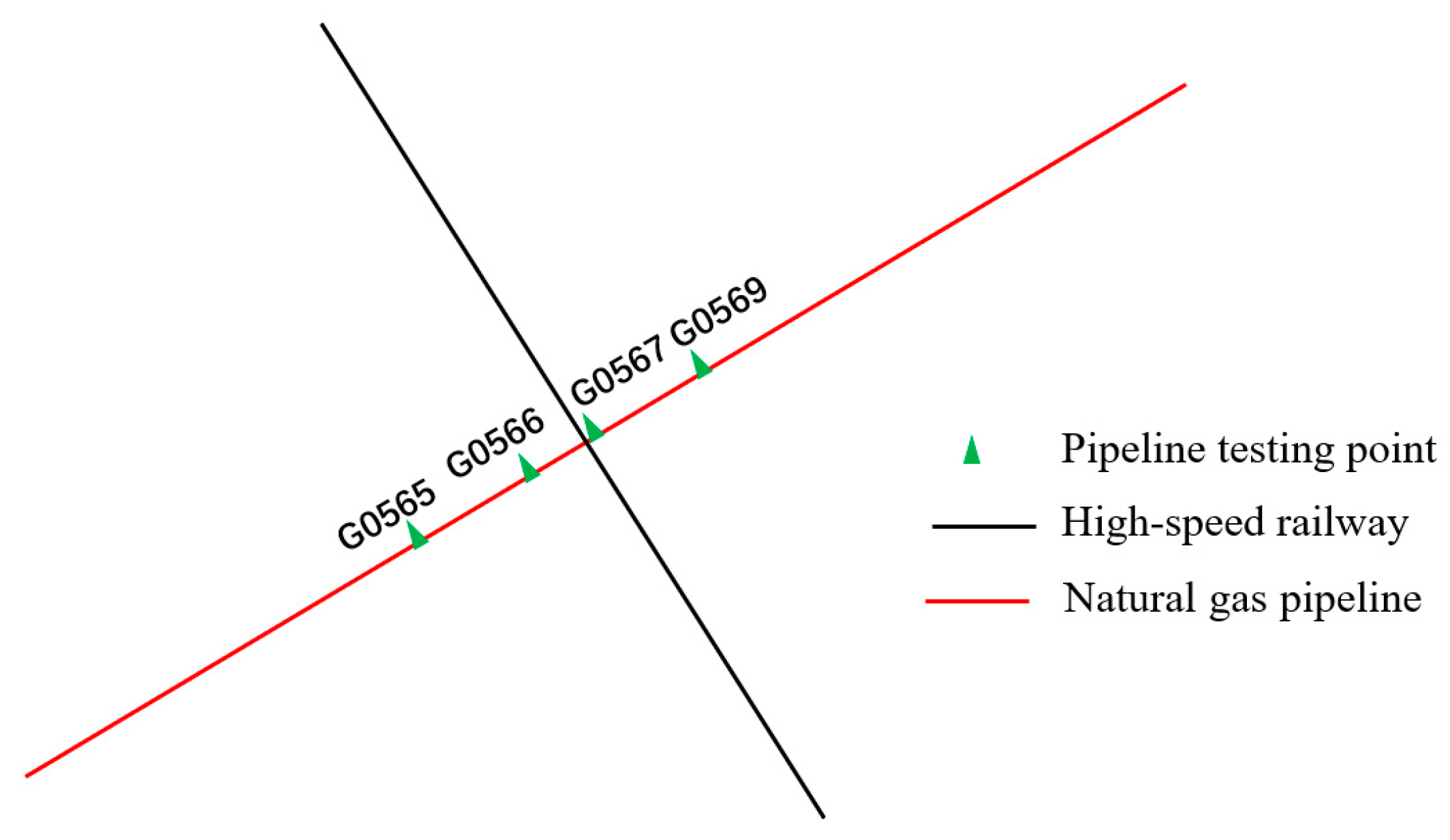
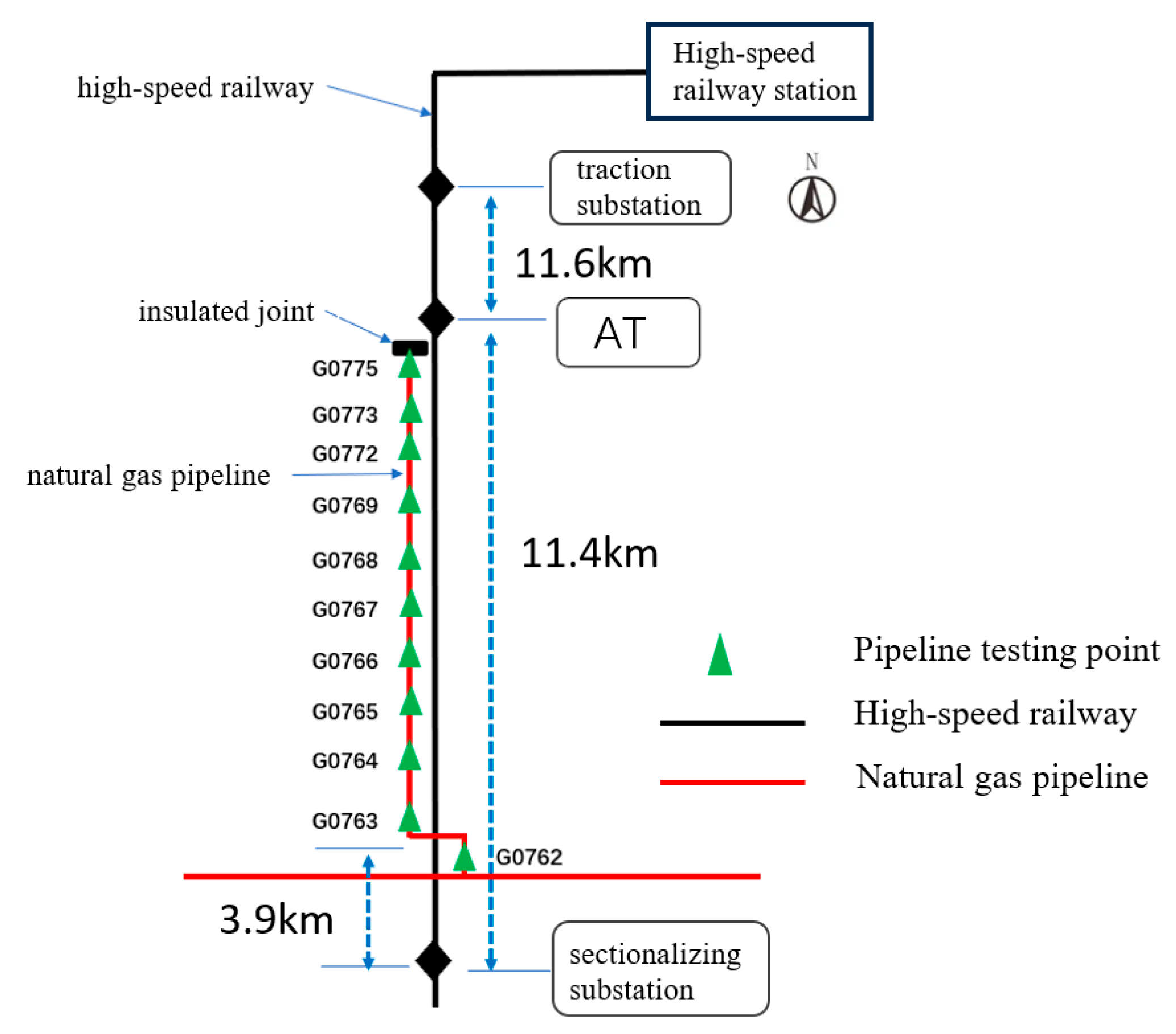



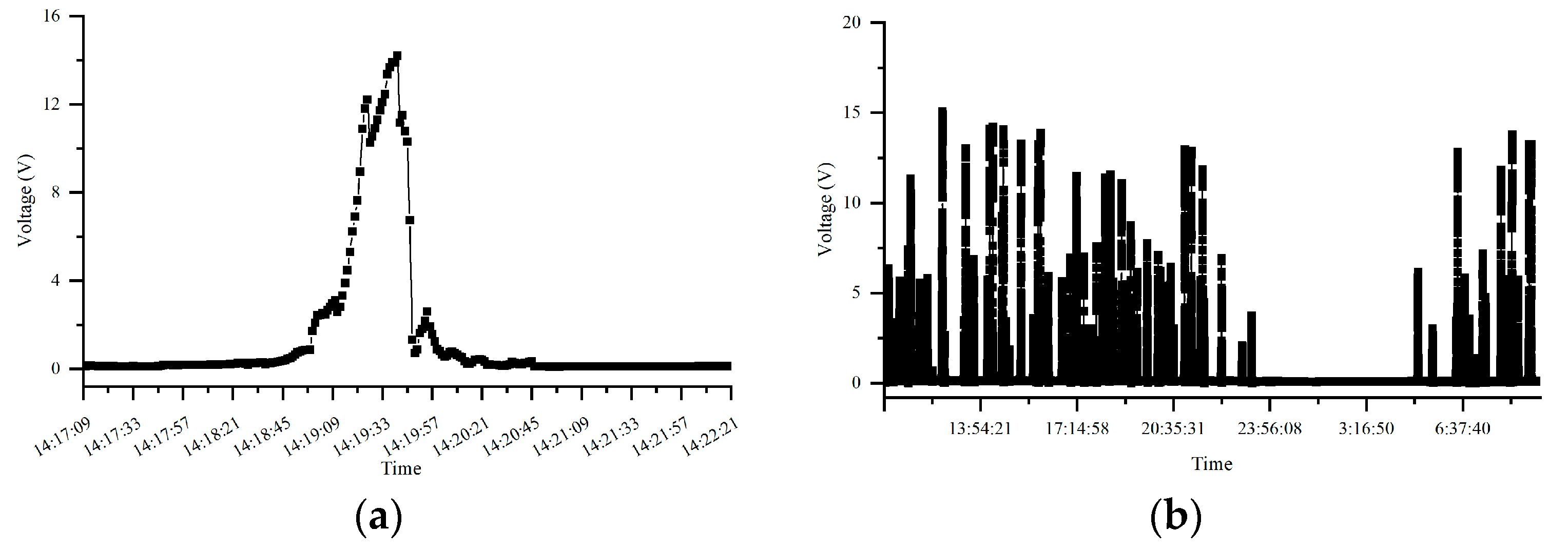
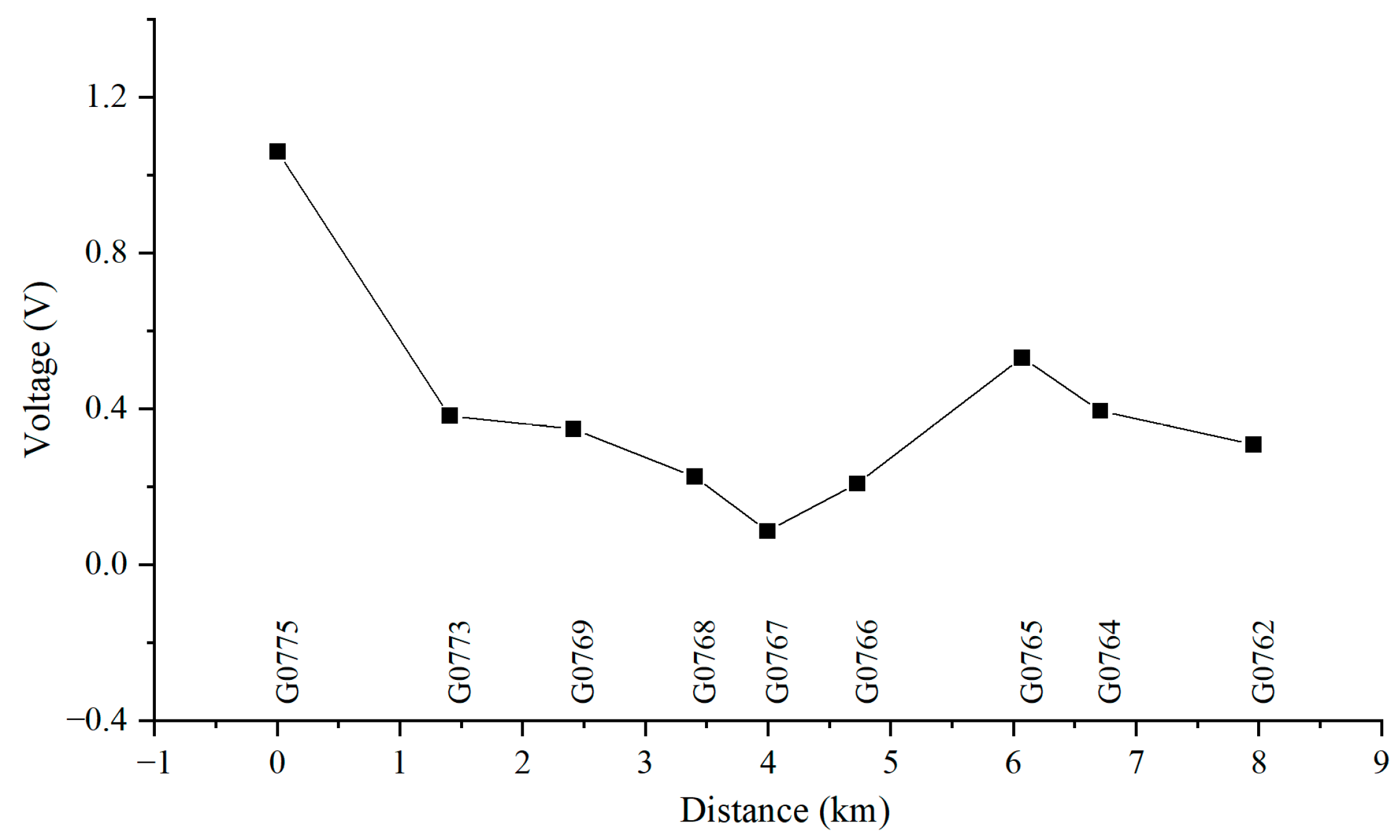

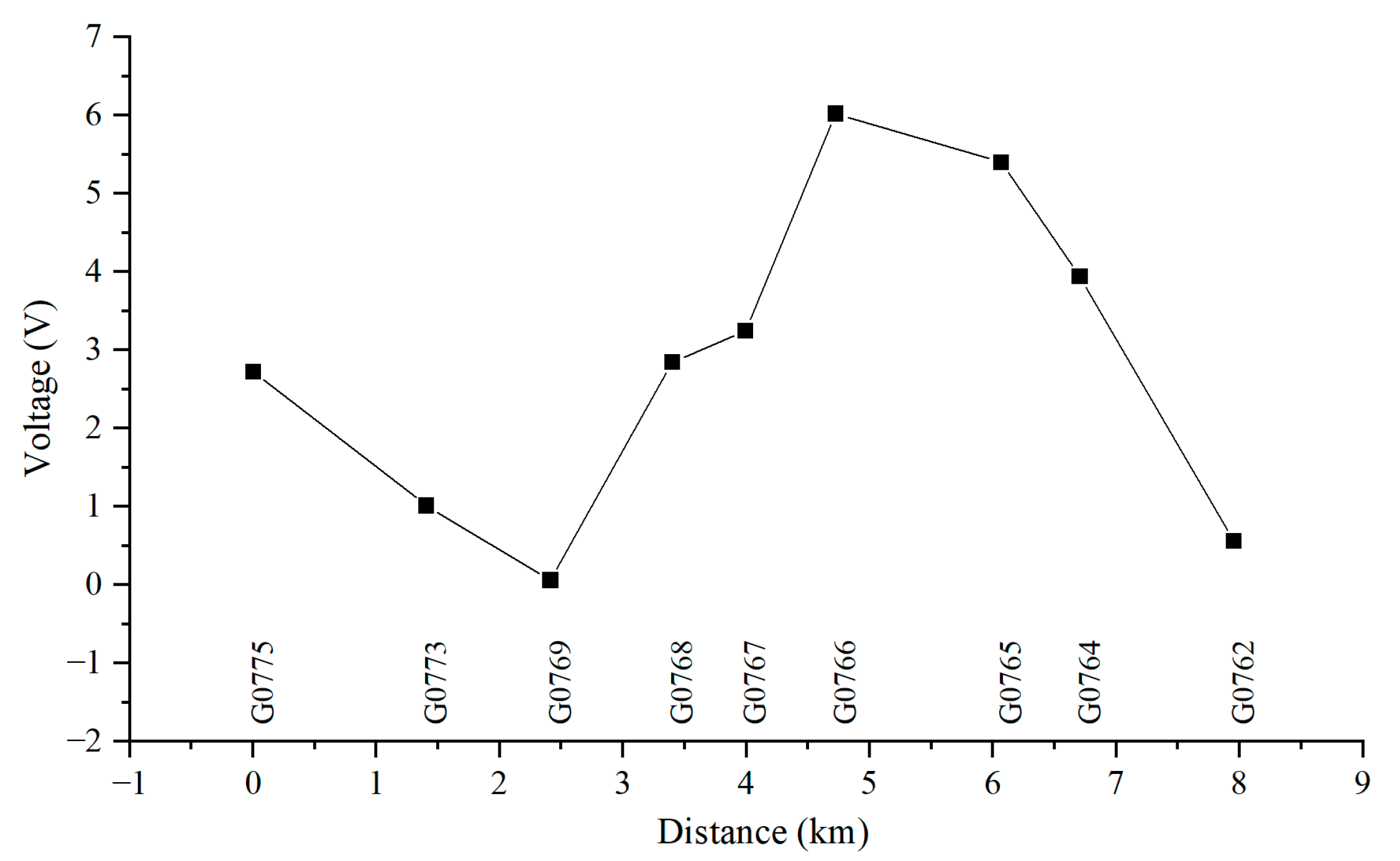
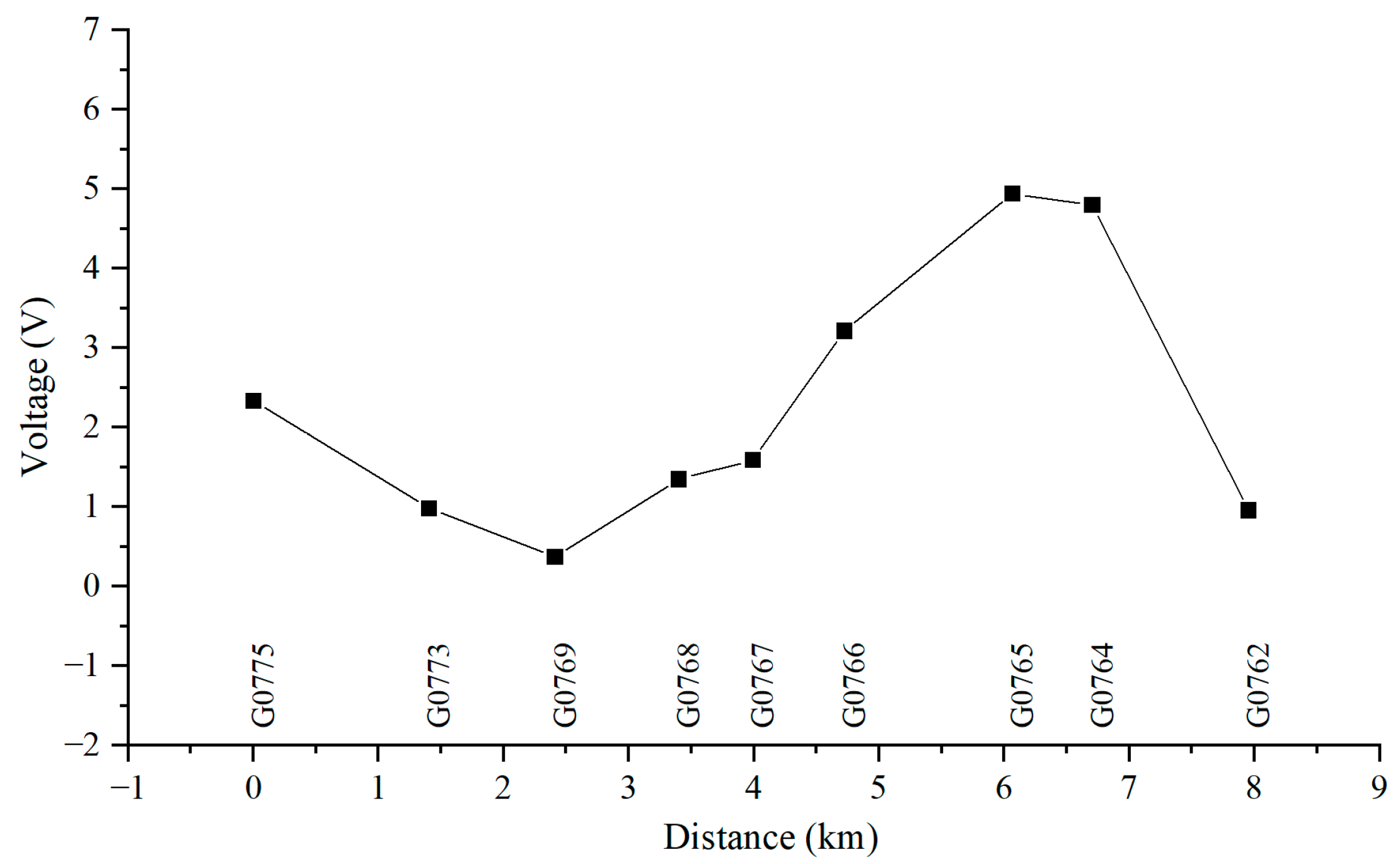

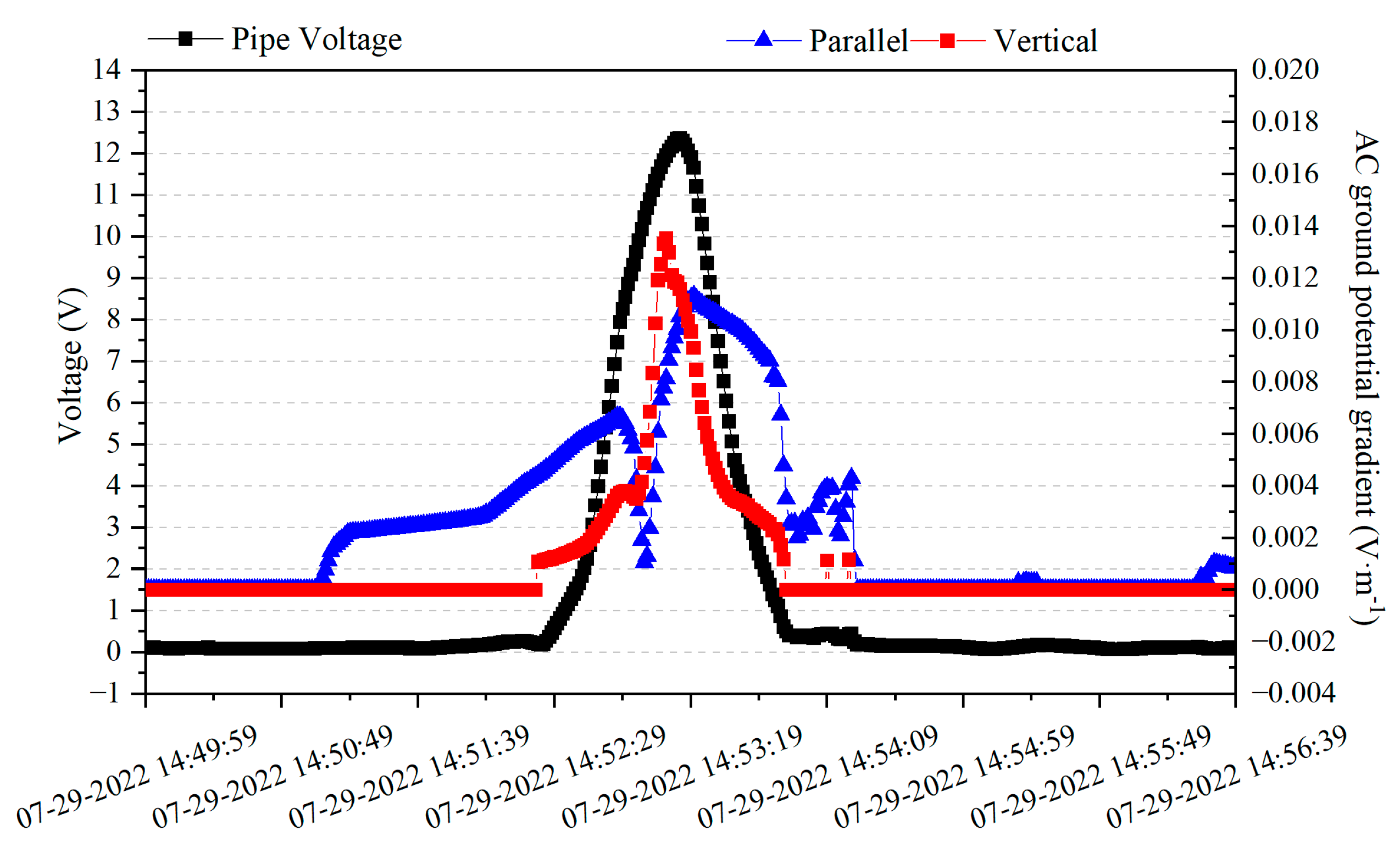
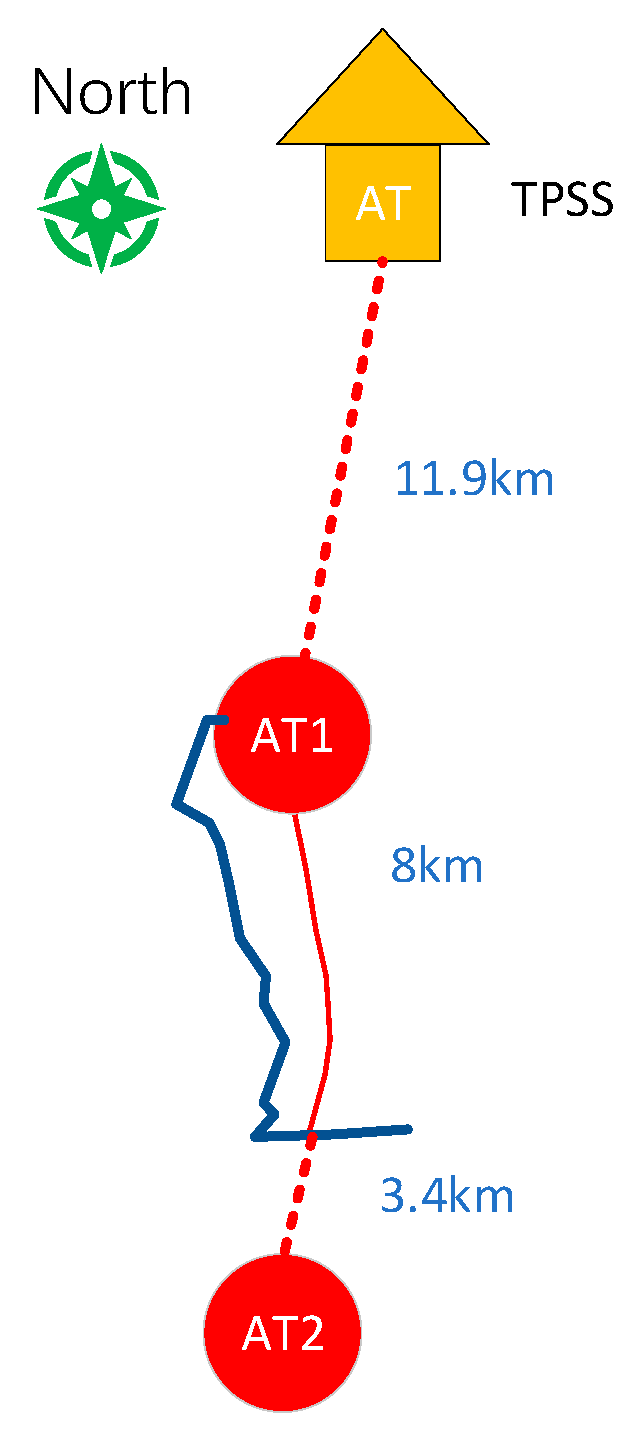



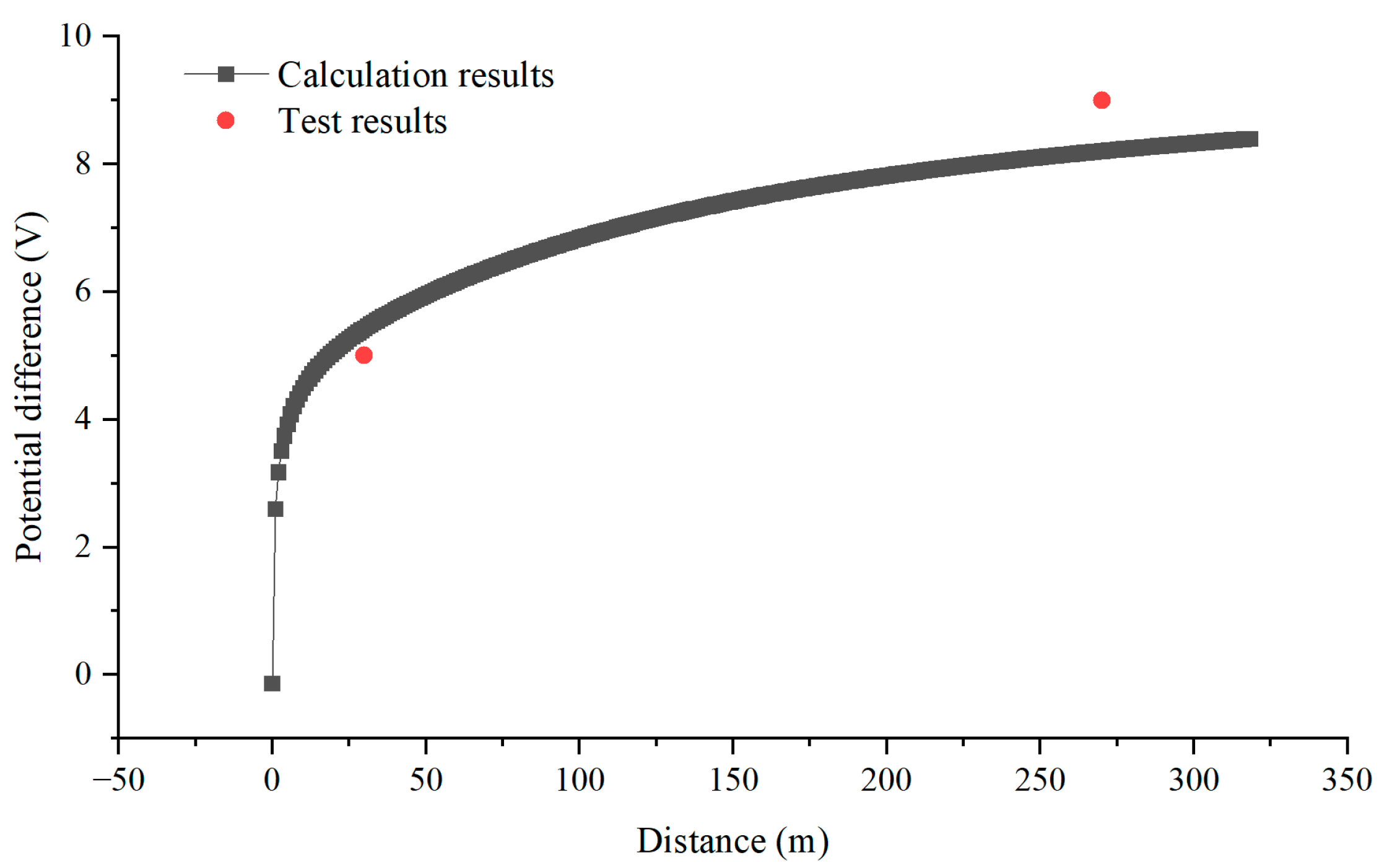
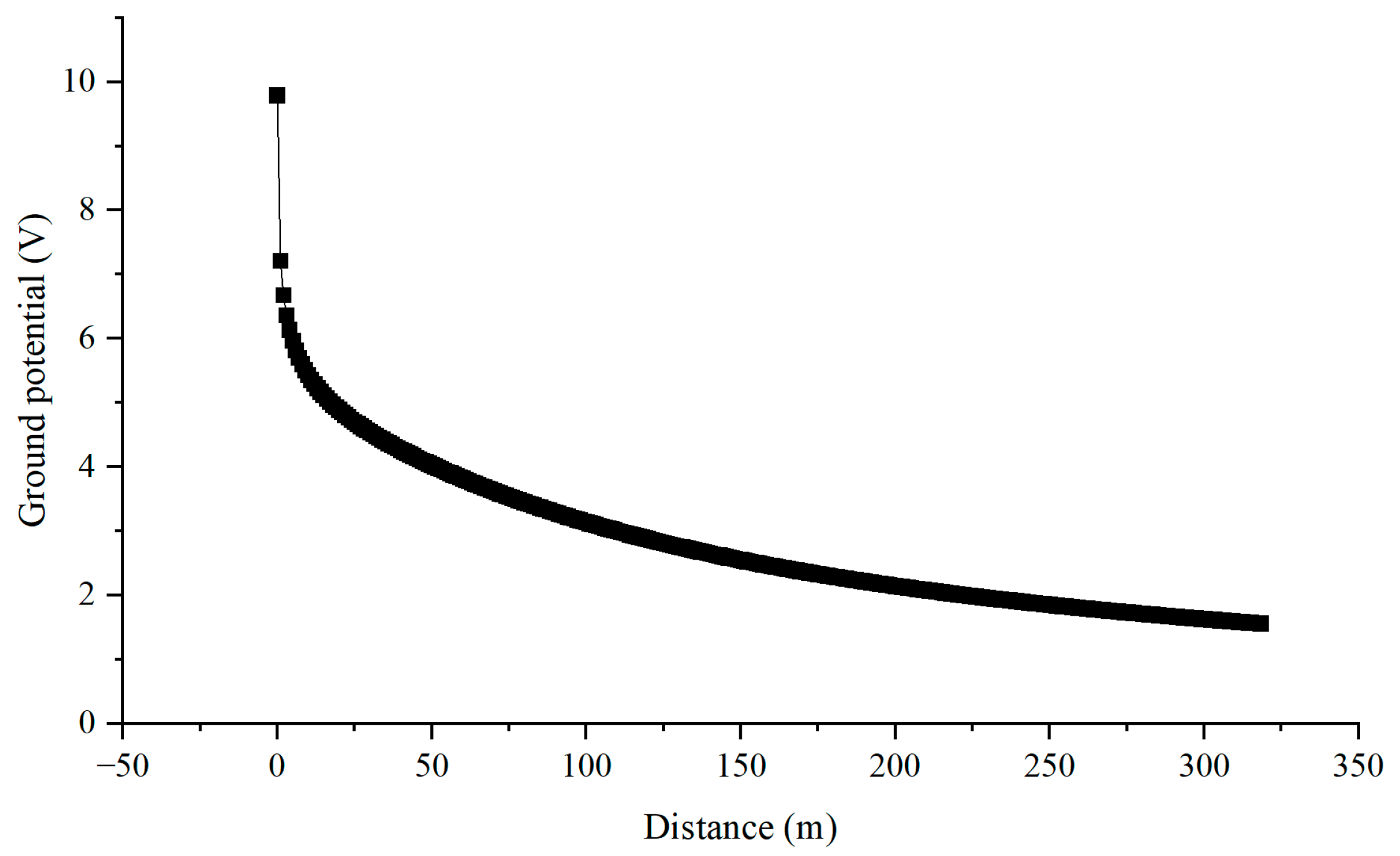

| No. | Data Name | Value |
|---|---|---|
| 1 | Internal resistance of CW | 0.183 Ω/km |
| 2 | Internal resistance of AF | 0.096 Ω/km |
| 3 | Internal resistance of Rail | 0.45 Ω/km |
| 4 | Leakage resistance of Rail | 15 Ω·km |
Disclaimer/Publisher’s Note: The statements, opinions and data contained in all publications are solely those of the individual author(s) and contributor(s) and not of MDPI and/or the editor(s). MDPI and/or the editor(s) disclaim responsibility for any injury to people or property resulting from any ideas, methods, instructions or products referred to in the content. |
© 2025 by the authors. Licensee MDPI, Basel, Switzerland. This article is an open access article distributed under the terms and conditions of the Creative Commons Attribution (CC BY) license (https://creativecommons.org/licenses/by/4.0/).
Share and Cite
Zhang, Y.; Ge, C.; Chang, Z.; Du, Y.; Lu, M.; Jiang, Z. The Interference Mechanism and Regularity Analysis of Gas Pipelines Affected by High-Speed Rail Based on Field Testing and Numerical Simulation. Materials 2025, 18, 4203. https://doi.org/10.3390/ma18174203
Zhang Y, Ge C, Chang Z, Du Y, Lu M, Jiang Z. The Interference Mechanism and Regularity Analysis of Gas Pipelines Affected by High-Speed Rail Based on Field Testing and Numerical Simulation. Materials. 2025; 18(17):4203. https://doi.org/10.3390/ma18174203
Chicago/Turabian StyleZhang, Yuxing, Caigang Ge, Ziru Chang, Yanxia Du, Minxu Lu, and Zitao Jiang. 2025. "The Interference Mechanism and Regularity Analysis of Gas Pipelines Affected by High-Speed Rail Based on Field Testing and Numerical Simulation" Materials 18, no. 17: 4203. https://doi.org/10.3390/ma18174203
APA StyleZhang, Y., Ge, C., Chang, Z., Du, Y., Lu, M., & Jiang, Z. (2025). The Interference Mechanism and Regularity Analysis of Gas Pipelines Affected by High-Speed Rail Based on Field Testing and Numerical Simulation. Materials, 18(17), 4203. https://doi.org/10.3390/ma18174203





